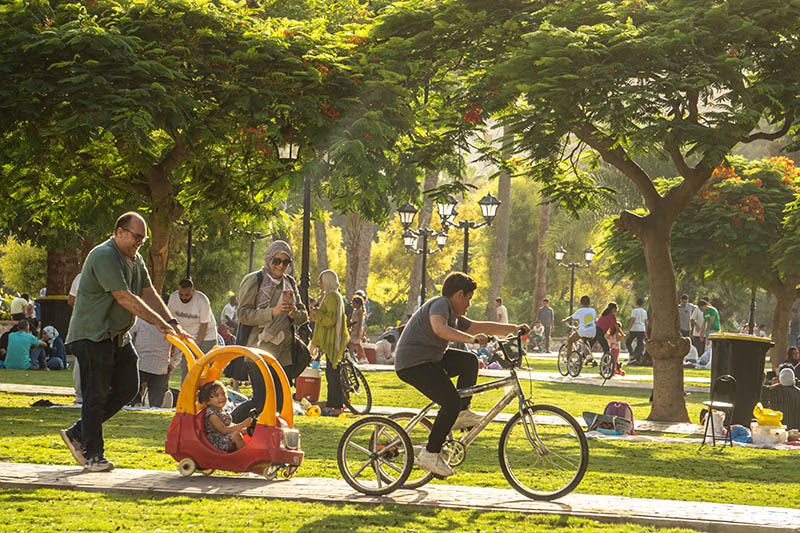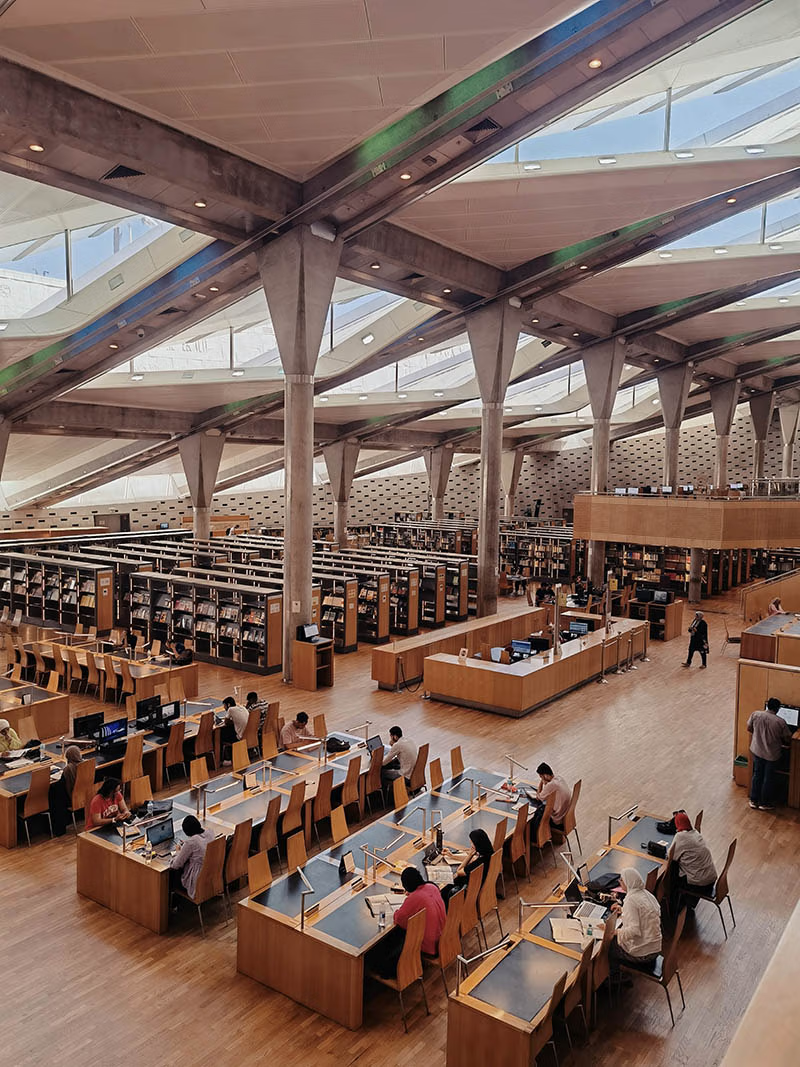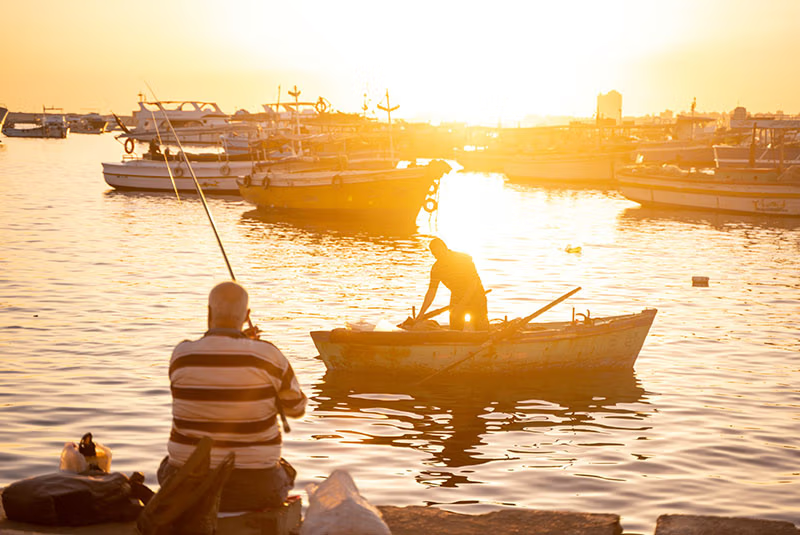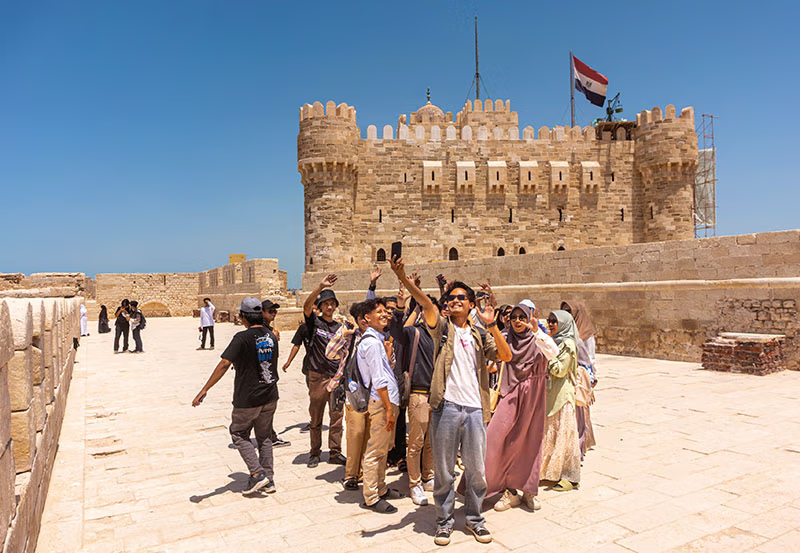The present and the past
Egypt’s ancient port city of Alexandria weaves layers of history and culture into a vibrant, modern metropolis.
By Rebecca Anne Proctor
Photographs by Ahmad Mansour
Aboard boats, their colourful paintwork faded by the intense sun, dozens of fishermen cast their lines into the turquoise waters of the Mediterranean Sea. Beyond, the Egyptian port city of Alexandria stretches along the coastline, encircling the fishermen like an embrace.
Founded in 332 BCE by Alexander the Great, ruler of the ancient Greek kingdom of Macedon, the city grew rapidly into a major centre for Hellenic civilisation. It even replaced Memphis as capital of Egypt for almost a thousand years, until its conquest by Arab armies in 642 CE. This grand city, Egypt’s second largest, still retains traces of its former glory, despite decades of political and economic turmoil and rapid development.
The elegant architecture that lines the corniche may not be aging gracefully, but there are many attractions in this city—new, old and very, very old—that beg to be visited. One is the Bibliotheca Alexandrina. Inaugurated in 2002 and designed by Norwegian architects Snøhetta, it is a modern reimagining of the ancient Library of Alexandria, once one of the greatest libraries in the world. Built near the city’s ancient harbour, the contemporary edifice’s tilting, circular form spans 160 metres in diameter, encircled by a reflecting pool. Its glistening roof recalls the ancient lighthouse of Alexandria—one of the seven wonders of the ancient world, it once overlooked this same harbour. The Bibliotheca connects, literally and metaphorically, to the old city via a footbridge linking it to the University of Alexandria.
Two walls of the façade are covered with Egyptian granite stones carved with 4,000 characters from most of the world’s known writing systems—not just alphabets but also musical and mathematical notation, Braille and barcodes. It’s a nod not only to the ancient library but also to the Rosetta Stone, which was found in a nearby town. Inside, the 11-storey library can hold up to four million books, the seven-terraced reading room, the world’s largest, can accommodate 2,000 people. Artefacts in the library’s collections include important Islamic objects such as sitaras (shrouds) that once covered the Kaaba in Mecca.

Opening image, the Graeco-Roman Museum, Egypt’s first purpose-built museum for preserving and displaying antiquities, opened in 1895. It reopened last October after an 18-year restoration. Above, the port city of Alexandria stretches along the Mediterranean coastline. This grand city, Egypt’s second largest, still retains traces of its former glory, despite rapid development and decades of turmoil.
Nearby, the Alexandria National Museum tells the story of the city and of Egypt through artefacts such as statues, weapons, religious icons, sarcophagi and mummies. Its three floors progress from the age of the pharaohs in the basement to the Greek and Roman period on the ground level to the Byzantine and Islamic periods above. The museum opened in 2003 in a restored Italianate mansion that previously housed the US consulate.Just down El Horeya Road, there are more antiquities, from the days of Alexander the Great to 641 CE, at the Graeco-Roman Museum. Egypt’s first purpose-built museum for preserving and displaying antiquities, it opened in 1895 but reopened last October after an 18-year restoration. Among 6,000 artefacts, it holds a cast of the Rosetta Stone (the original is in the British Museum), Tanagra figurines and, in its courtyard, an 11-metre statue of the goddess Isis. The statue was found in the 1960s by Egyptian diver Kamel Abu el-Saadat in the waters close to Fort Qaitbay.
A short walk towards the main railway station, Alexandria’s Roman amphitheatre is the only one of its kind in Egypt. Built during the 4th century CE (and rediscovered only in 1960 when foundations were being laid for a government building), the amphitheatre’s columns and 13 white-marble terraces are a reminder of the prosperous Greco-Roman period. Seating 700-800 spectators, the amphitheatre was once covered by a roof and was used for performances rather than sporting events. The site includes vestiges of thermal baths, lecture halls, and what was an upscale residential area with exquisite mosaics of lotus flowers and birds. The site is known as Kom El-Dikka, or “hill of rubble”.


Top, the Antoniadis Gardens are among the oldest in the world, dating to the Ptolemaic dynasty. Above, Bibliotheca Alexandrina is a modern reimagining of the ancient Library of Alexandria, once one of the greatest libraries in the world.
But Alexandria’s charms aren’t limited to antiquity. Take the tram to San Stefano station for a different kind of gem: the Mahmoud Said Museum. The Italianate villa was once home to its namesake, a native of Alexandria. One of Egypt’s foremost modern artists, Said is renowned for his rich paintings of people and landscapes that capture the mood of the period between the 1920s and his death in 1964, a time of great change. Known especially for his portraits of women, Said celebrated Egyptians from all classes, the plebeians to the aristocrats.
The villa’s upper floor showcases the work of brothers Adham and Seif Wanly. Seif, like Said, has come to international prominence over the past decade. More subdued, edgy and melancholic than the sensuous scenes of Said, his paintings offer another window into Egypt in the mid 20th century. Both Said and Seif Wanly portrayed the political and social transformations of the times, from patriotic marches to the 1919 revolution—the popular movement against the British occupation of Egypt and Sudan.
Not as old yet another piece of history, the Steigenberger Cecil Hotel, on Saad Zaghloul Square, a 15-minute walk along the corniche from the Bibliotheca, offers expansive views of the Mediterranean and a dose of old-world glamour. The hotel has kept the same classic French style as when it was built in 1929 by the Franco-Egyptian Metzger family, with dark wood interiors and sumptuous touches of colour and detail. The hotel appears in literary works such as The Alexandria Quartet by Lawrence Durrell and the novel Miramar by Egyptian Nobel laureate Naguib Mahfouz.
For coffee, seek a table, and sanctuary, at Délices close to the Steinberger Cecil. Opened in 1922 by the Greek family that still runs the café today, Délices is known city-wide for its pastries.
Alexandria has many places to eat excellent Egyptian food, such as samak singari (fish cooked in tomatoes with coriander, cumin and chili) and foul Eskandarani (fava beans with bell peppers, tomatoes and a dash of vinegar). Fish Market, on the corniche, may be the city’s biggest restaurant and is always packed with locals and visitors enjoying fresh fish with waterfront views.


Top, Alexandria is Egypt’s window to the Mediterranean. Fisherman have long cast their rods and nets into its turquoise waters. Above, Fort Qaitbay, built over the ruins of Alexandria’s storied lighthouse, served as the city’s defence against naval attacks.
Sidra by the Citadel, immediately behind Fort Qaitbay, offers exquisite Lebanese dishes and views of the ancient harbour. The fort, built by the Mamluk sultan Al-Ashraf Abu Al-Nasr Qaitbay between 1477 and 1479 AD over the ruins of Alexandria’s lighthouse, served as the city’s defence against naval attacks. It remains one of the most striking buildings on the coastline and worth a visit itself, particularly for sunset.
The Antoniadis Gardens, in the city’s east, offer not only a green oasis but more time travel. These gardens are among the oldest in the world, dating to the Ptolemaic dynasty that ruled Egypt from 305 BCE to 30 BCE. Under restoration, the 48 hectares of gardens today reflect a more recent vision, that of John Antoniadis, a Greek cotton merchant who in 1860 built a smaller copy of the Palace of Versailles and who added statues of European explorers to the Greek gods already there.
On the city’s eastern seafront, the vast Montazah Gardens house two palaces. Salamlek was built in 1892 by Khedive Abbas Helmy II, the last viceroy of Egypt, as a hunting lodge but is now a hotel. The more spectacular Haramlek (more commonly known as Montazah Palace) was commissioned by King Fuad in the 1920s as a summer residence in a combination of Florentine and Byzantine styles (its taller tower resembles the Palazzo Vecchio in Florence). It is no longer open to the public, but visitors can pay to walk or picnic in the lush gardens.
To get the essence of this ancient city’s past and present, walk its streets and alleyways, amid its rich architectural heritage and its current inhabitants. Urban development has seen the destruction of 100 of the 1135 heritage buildings listed by the government in 2007. Local architect Mohamed Gohar has set up a database, Description of Alexandria, to document, and protect, those that remain.
End the day with a walk along the corniche to enjoy the skyline and sea breezes. Cross Stanley Bridge, whose mix of Greek, Roman and Egyptian styles reflects the city’s shared heritage—though the bridge only opened in 2001. Along its length, fishermen dangle lines over the side, and old men play backgammon at makeshift tables. The seamless blend of activities and cultures against a beautiful backdrop sums up the cosmopolitan, multi-layered spirit of Alexandria.



